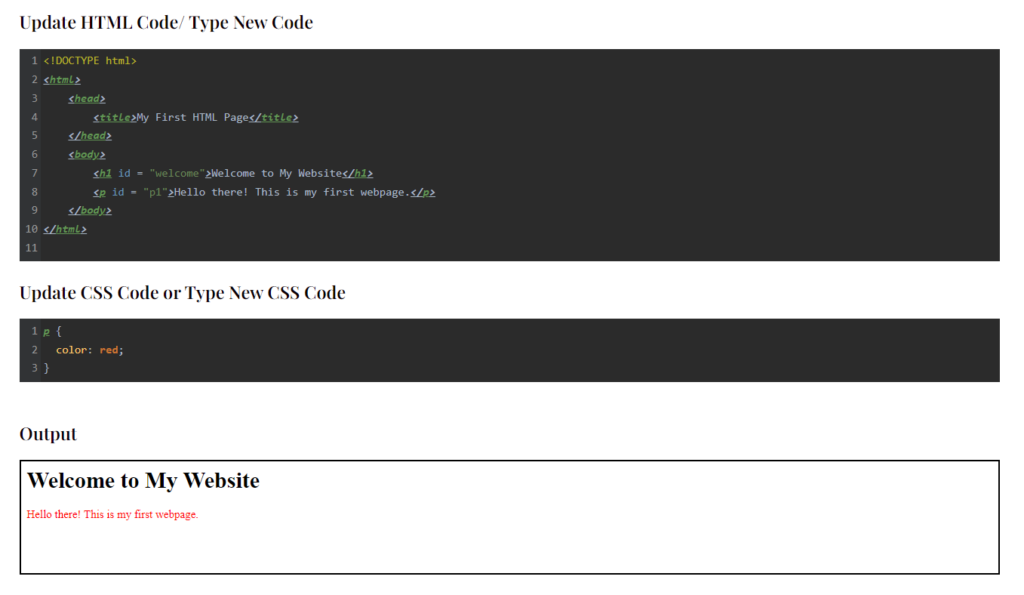Introduction to CSS
CSS, i.e. Cascading Style Sheets is the language that adds color, layout, and life to your web pages.
Table of Contents
A Tale
Once upon a time, in the vast land of Webtopia, there lived a small, overlooked tag named TinyText. TinyText was sad because, next to its flashy neighbors like BoldButton and FancyFont, it felt plain and unnoticed. One day, TinyText met a wise old sage named CSSorcerer, who saw its potential and decided to share the secret of the “Style Spell.”
With a flick of CSSorcerer’s wand (and a few lines of CSS code), TinyText was transformed! It donned a cape of color, a hat of height, and boots of boldness. No longer was it the plain tag in the corner; TinyText became the most captivating text in all Webtopia, dancing across screens with grace and flair.
The moral of the story? Even the simplest element, with a touch of CSS magic, can become the star of the show. So, dear reader, remember the tale of TinyText as you embark on your CSS journey. With the right styles, who knows what transformations you might achieve!
What is CSS?
CSS, or Cascading Style Sheets, is the secret sauce that brings your web pages to life. It’s the stylist of the web, working alongside HTML (the skeleton) to create stunning and functional web pages.
Here’s a taste of what CSS looks like:
body {
background-color: lightblue;
}Code Output
If you run the above code online Clicking the “Run this Code Online” button, you will see how the above CSS code is styling above HTML.

In this snippet, body is the selector, background-color is the property, and lightblue is the value. This simple line of CSS will transform the background color of your webpage to light blue. Pretty cool, right?
Getting Started with CSS
There are three ways to include CSS in your HTML files: inline, internal, and external.
Inline CSS
It is used within the HTML tags. It’s useful for applying unique styles to a single HTML element. However, it’s not the most efficient method if you want to style multiple elements.
<p style="color: red;">This is a paragraph with inline CSS.</p>In this example, the style attribute within the p tag is used to apply inline CSS. The text color of this specific paragraph is set to red.
Internal CSS
Internal CSS is written in the head section of the HTML file. It’s useful when you want to style a single web page.
<head>
<style>
p {
color: red;
}
</style>
</head>In this example, the style tag within the head section is used to apply internal CSS. The text color of all paragraphs on this page is set to red.
External CSS
External CSS is a separate file linked to the HTML file. It’s the most efficient method when you want to style multiple web pages with the same styles.
<head>
<link rel="stylesheet" href="styles.css">
</head>In this example, the link tag within the head section is used to link an external CSS file named styles.css. All styles defined in styles.css will be applied to this HTML page.
Wrapping Up
Well done, you’ve made it to the end of this CSS journey! We’ve covered the basics of CSS. Remember, the key to mastering CSS is practice, so don’t hesitate to get your hands dirty and start styling!
Frequently Asked Questions
- What is the introduction of CSS?
CSS, or Cascading Style Sheets, is a style sheet language used for describing the look and formatting of a document written in HTML. - How to learn CSS as a beginner?
Start with the basics of CSS, like syntax, selectors, and properties, then move on to advanced topics like layouts, animations, and responsive design. - What is CSS in layman’s terms?
CSS is like the stylist of a web page. It’s used to give the web page a unique look and feel. - Is CSS good for beginners?
Absolutely! CSS is a fundamental part of web development and is a great starting point for beginners.
